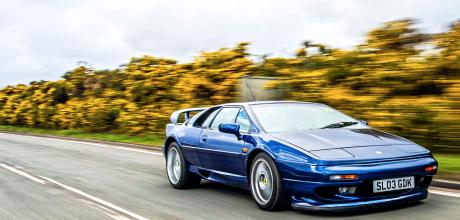2003 Lotus Esprit V8
Lotus lover Sam Hunt adores his Series 1 Elise, but would he like the range-topping Esprit V8 more? With the keys to one of the last Hethel wedges ever made, he’s about to find out.
Words EMMA WOODCOCK
Photography IAN SKELTON
The List
Reader Sam Hunt gets to grips with the last-of-the-line Lotus Esprit V8
‘The steering, the pedals, that surge! It all makes sense now’
Reader and Lotus fan Sam Hunt drives the Esprit’s 2000s swan-song
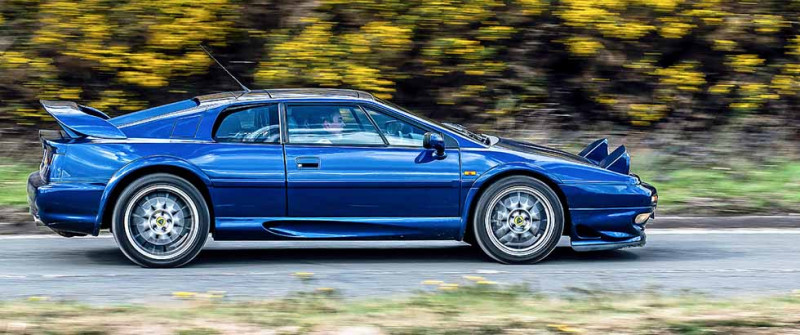
Yes yes, yes! There she goes!’ Sam Hunt whoops and shouts as the 2003 Lotus Esprit V8 squats into its fat rear tyres as its twin turbochargers light up. Grinning, bouncing, eyes flickering about to take in every detail, the lifelong Lotus fan is watching his dream come true. ‘I’ve pushed past 4000 revs and she’s just come alive – it’s like I’ve unleashed her. The steering, the pedals and, god, that surge! It’s all starting to make sense.’ Already a proud Series 1 Elise owner, Classic Cars reader Sam always wanted to experience the best and brightest the Norfolk sports car manufacturer could produce, so we’ve arranged for him to spend today driving one. He seems impressed, but I’ll let him speak for himself.
‘The acceleration is incredible. I’m thrown back, every part of my body moving with the car. It’s like nothing I’ve ever experienced’
‘It’s a supercar, I don’t care what other people say. The Esprit is the closest thing to a supercar I’ll probably ever experience and it’s so completely designed for speed. Just feel it through these fast A-road corners. The steering is still sharp, the chassis is still stable. Even that immense body width starts to suit it. I could take it straight up to 160mph or so and still be perfectly safe, I’m sure of it. And that’s so different from the Elise. In the Series 1 I’m just sat there in that exposed aluminium frame, so it feels rough and almost too fast at 60mph! The V8 is so much smoother and more complete, plus it absolutely flies.
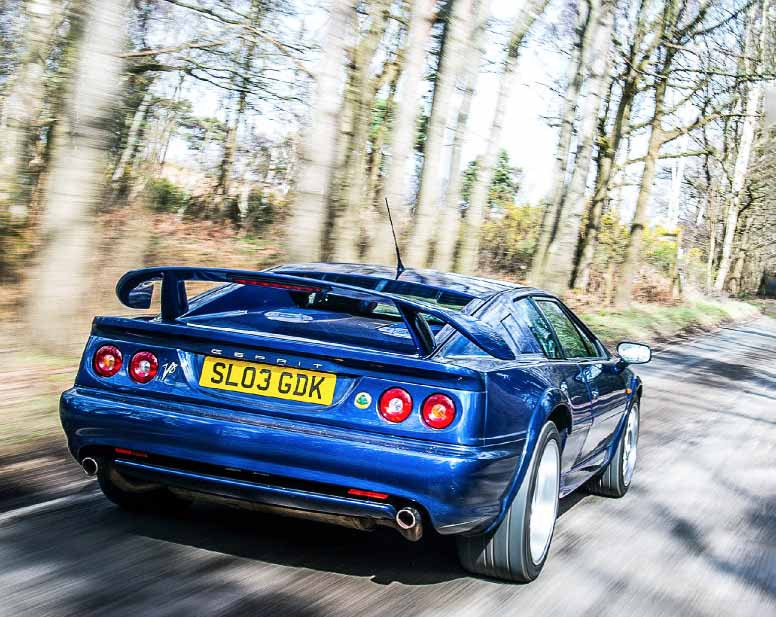
‘This is how you know you’ve really made it,’ he asserts as we pull over for a break. ‘The sheer presence of the shape speaks for itself. Every time we park up, I can’t stop looking at it. The classic wedge is so apparent within the slightly modernised styling of the bumpers and the badging, its folded paper lines so perfectly encapsulating decades of Lotus heritage. That said, I really like the Series 4 re-design. Julian Thomson’s little touches mean a lot to me as an Elise owner, because he styled my car too.’
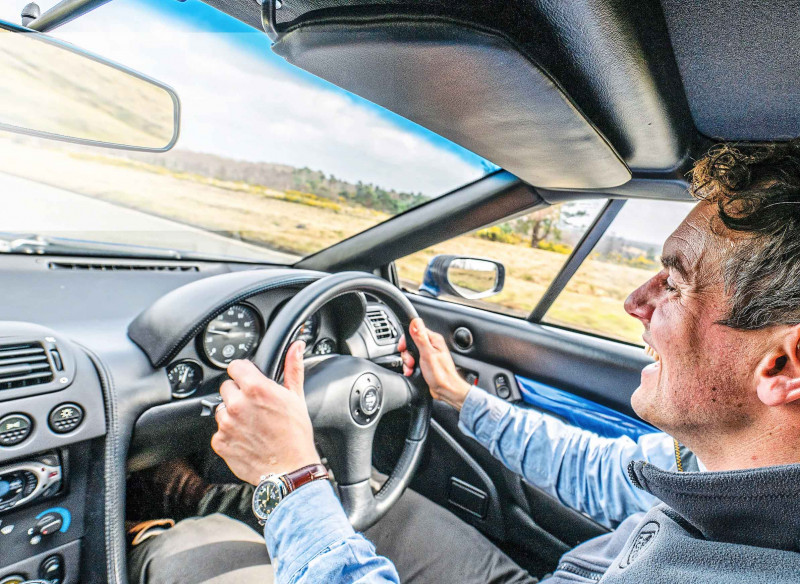
We pause at the rear, where 2002-onwards Esprits boast quad circular lamps in place of the two red bricks used in all earlier production. ‘They’re adding another bit of Elise, this time from the Series 2! Compared to the old Toyota-badged light units they’re an absolute treat. I’ve always thought they look so hot, and I still do! They’re one of my favourite features.
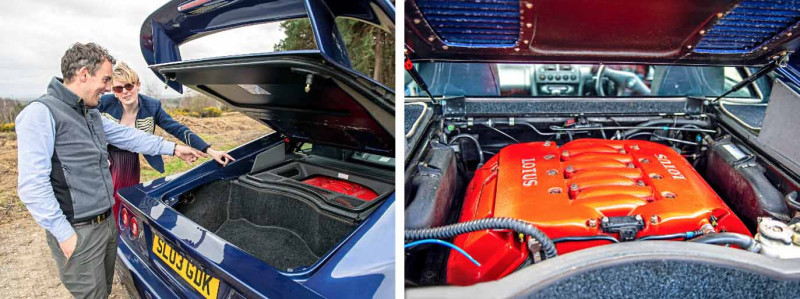
‘Lotus kept building the Esprit for so long but it was always wanting for a proper, decent engine until the eight-cylinder came along. That’s what finally made it a supercar, and the only Lotus supercar to date, in my view. I can’t get enough of the rumble when I start up the V8, the wooshing noise of the turbos, the way it throws me back in the seat when I get the throttle down. I love it, I love everything about it, not to mention that it’s a proper handbuilt British hero. I’d like nothing more than to pull up at work behind the wheel, feeling absolutely white hot!’
He wasn’t so confident half an hour ago, when he first shimmered behind the wheel. The sheer size of the car formed his first impression, followed swiftly by its capacity for intimidation. ‘It’s wide, huh? So wide. And it feels really large, even compared to today’s cars, like the wedge shape starts up front and continues through the whole vehicle. I’m sitting right at the arrowhead and rear visibility… isn’t great. Everything around the B-pillar is a massive blind spot. I’m a bit scared, I don’t mind saying! I’ve never driven anything so fast and that rumbling engine is weighing on my mind.’
‘I’m tickling the clutch so carefully – the action is so acute – and it’s demanding surprisingly high revs to get moving. Phew! I haven’t stalled but it felt close; this isn’t an easy car to handle at parking pace.’ Things didn’t get much easier when he gently arced out of the car park. ‘The pedals are so close together, the steering is keen and the cabin is filling with an endless, distinctive ‘skreeee’. It can’t wait to get out onto the road – it hates being at low speeds.’ He jabbed the throttle in response.
‘Acceleration comes in such a sudden jerk, all that force going into the back wheels. It’s a worry but the soundtrack is amazing!’ Those frets and would-be threats are dissipating fast as his experience grows, so he’s nothing but smiles when we pull up for a quick history lesson with Max Kingsley-Jones, the car’s owner. ‘As the dashboard plaque shows, this is one of the final 15 Esprits built for the British market. Only eleven are still in the country. I’ve wanted one of them ever since 2003, when I photographed the very last UK car at Hethel for Club Lotus. It was black-and-gold and I missed my chance to buy when the first owner finally sold it. So when I saw my Cobalt Blue car a few years later, I was determined to make it mine! It’s the very last made in this colour, and completely original.’
‘I really appreciate that,’ Sam replies. ‘Sitting in here is like going back to 2003. Max has even kept the original Minidisc player, not that I had one back then. The buttons for the various lights are more familiar. They’re the same as my Elise… and my Peugeot 106 first car! It’s nice to have physical, finger-sized controls – instead of the touchscreens that are so popular in current cars – and they add a little French chic.’ Using the lights is a little more alien. ‘Today’s my first time driving a car with pop-up headlamps. I’d never realised how slow they’d be to rise and I could swear the cabin vibrates as they jolt into position!
‘But they look brilliant once they’re up! Seeing them flick above the bonnet makes the car come alive. They’re so far away, across that combination of long bonnet, dashboard and windscreen. It’s the arrowhead again. You just don’t get that in cars any more. We’re right in the small section that contains all the best visibility.’ The cabin impresses just as much. ‘I’m so comfortable in this very low armchair, complete with its Elisematching lumbar pump, and everything is so refined compared to my expectations of a Lotus. Bare aluminium is nowhere to be found and there’s no giant sill beside me, so it’s surprisingly easy to get in and out.’
‘It’s the Elise’s bigger, older, more refined sister,’ he adds a few minutes later, stoking the Lotus along in a longlimbed cruise. ‘All it takes is getting above 40mph or so and the Esprit really comes together. There’s constant power behind my back, all there and always, yet it’s so smooth, so refined and remarkably quiet from inside, without ever losing that rumble. Oh, to give it a long racetrack straight! It takes some learning but the whole car is built for speed and that’s what it wants to do.’
Rushing towards a tightening bend, Sam uncovers a weak link in the chain. ‘It doesn’t half skip and jump around when I hit the brakes. They’re giving feedback like a Nineties French hatchback, by which I mean I’m pushing them and getting no real sense that anything is happening at all. It feels like metal grinding on metal, and the pedal just isn’t very responsive. I wouldn’t want to rely on these to stop from three figure speeds! Not that it’s a criticism, it’s just part of the all original experience.
‘At least I’m getting more used to the gear selection,’ he continues. ‘The clutch bites so high and narrow, which means I have to bring it up then get it exactly into this tight range to engage power cleanly. Anything less and it shudders, which adds a real analogue feel. That’s a big part of the Esprit appeal. That’s driving the Lotus way, with nothing more than the dials, the controls, the road and all the speed you can get. It’s exactly what appealed when I first drove an Elise about ten years ago. We’ve lost that in modern cars.
‘The Renault 25 transaxle is just okay but I’m learning how to unlock its best. The stick only needs the smallest touch before it goes its little distance into gear, with a subtle ker-schlick feeling when it goes in. And, you know what, it’s a better shift than my Elise. Not that I’d call that particularly high praise!’ The miles fly by and his inputs get ever smaller and more assured. ‘That’s more like it! I’m careful now not to hesitate with any of the pedals, with any of the car. How brilliant this would have seemed alongside Noughties BMW M3s or Porsche 911s! It’s one of the last and greatest analogue driving machines.’
Sam peels off a roundabout and slingshots through second, third, fourth. The exhaust hammers but even that can’t drown out his gleeful giggling. ‘Ha ha ha! This is immense, isn’t it?! The acceleration is incredible. As soon as I hit 4000rpm there’s a jump and I’m thrown back, every part of my body moving with the car. It’s like nothing I’ve ever experienced. Woof! The power arrives with no delay and just wants to fly, yet it’s so trustable!
‘I’ve not even got close to getting the throttle all the way down but it’s still so fast. The pedal travel just keeps going and going, maybe twice as far as the throw on my Elise, with ever more performance to come. It’s the perfect engine for the car, wooshing and roaring and adding so much excitement.’
He clicks back into fifth for the burble back to our goodbyes, the Esprit showing the best of its fine manners. ‘I could happily head out for a long, long drive, spanning 300 miles or maybe more, which I wouldn’t say of many Lotus models. In my Elise I never make it past 100 miles! The sound is hushed and the ride is quite incredibly smooth at any speed over 20mph, while the bodyshell and perfect driving position leave me feeling so secure. It’s proof that the new Emira isn’t the first luxury Lotus. ‘I can’t drive it without smiling,’ Sam concludes. ‘It’s lived up to every expectation I had. I wanted a car that’s as quick as a Tesla but leagues more fun, with the four-dimensional feeling only a classic can provide. The 2003 V8 gives me that, with the added heritage of an in-house Lotus engine behind my shoulders. It stays in my top ten, without a doubt. The noise, the excitement and that engine are just bloody brilliant.’
‘I can see why they’ve got such a following: the V8 has its own added chic!’
TECHNICAL DATA 2003 Lotus Esprit V8
- Engine 3506cc twin-turbocharged Lotus Type 918 V8, dohc per bank, EFI Technology sequential fuel injection
- Max Power 349bhp @ 6500rpm
- Max Torque 295lb ft @ 4250rpm
- Transmission Five-speed manual transaxle with synchromesh, rear-wheel drive
- Steering Rack and pinion, hydraulic power assistance
- Suspension Front: independent by double wishbones with coil springs, telescopic dampers and anti-roll bar. Rear: independent by upper and lower transverse links with radius arms, coil springs and telescopic dampers
- Brakes Servo-assisted, Kelsey Hayes ABS. AP Racing cross-drilled and ventilated discs all round
- Performance Top speed: 175mph;
- Acceleration 0-60mph: 4.8sec
- Weight 1380kg (3042lb)
- Fuel consumption 21.2mpg
- Cost new £49,990 (2002)
- Classic Cars Price Guide £21,000-£42,500

Relatively decent boot space is a foreign concept to Elise owner Sam. Twin-turbo, dohcper- bank V8 is a thoroughbred Lotus unit
‘Its folded paper lines so perfectly encapsulate decades of Lotus heritage’ Leather extends to dashboard and transmission tunnel for upmarket feel
Bulkhead restricts seat adjustment, but Sam fits just fine. Sam heaps particular praise on the hydraulic rack and pinion steering


